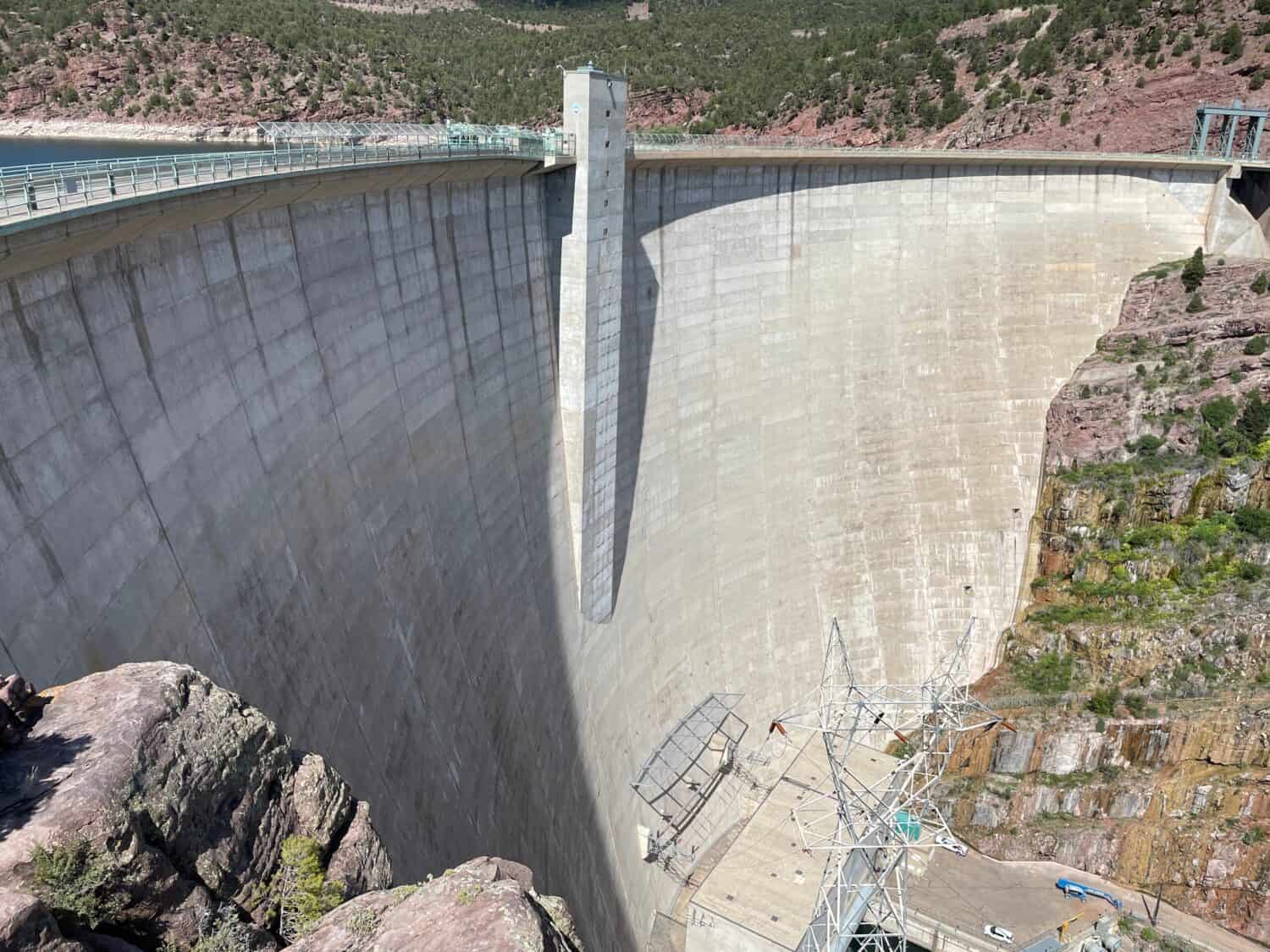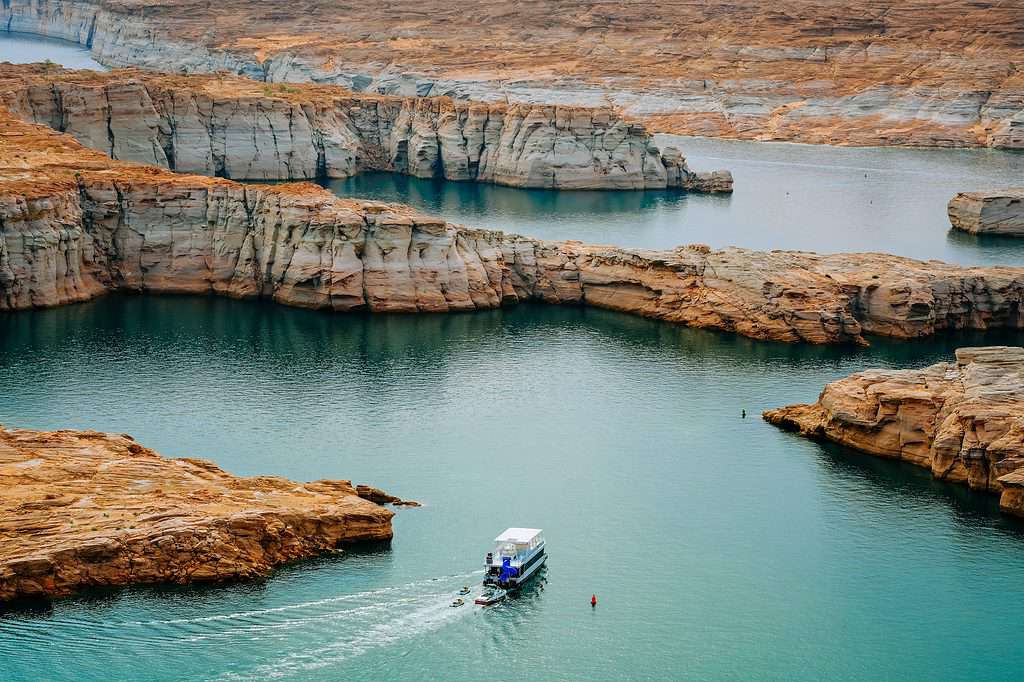Dams are some of the most important structures for any civilization. By halting the flow of water from a river, dams can form reservoirs to provide hydropower, drinking water, and water for crops. Some of them are immense concrete structures while others are earthfill embankment assemblies. Utah is like other states in the western United States that must control water as a resource by using dams. Learn about the largest dam in Utah and see where it’s located and how it measures up to some others around the world.
What Is the Largest Dam in Utah?

The Flaming Gorge Dam is a massive construction that took four years to build.
©Eli T Webb/Shutterstock.com
| Flaming Gorge Dam Statistics | |
|---|---|
| Height | 502 feet |
| Length | 1,285 feet |
| Spillway Capacity | 28,000 cu ft/s |
| Power Generated Per Year | 500,000,000 KWh per year |
| Reservoir Capacity | 3,788,700 acre-feet |
The largest dam in Utah is the Flaming Gorge Dam, a concrete arch dam that stands 502 feet high and measures 1,285 feet long. The structure has a spillway capacity of 28,800 cu ft/s. The Flaming Gorge Dam was built on the Green River starting in 1958 as part of the larger Colorado River Storage Project.
The goal of the Colorado River Storage Project was to manage the flow of water from the areas in the Upper Basin such as Colorado, Utah, Wyoming, and New Mexico into the Lower Basin. The lower basin consists of Arizona, Nevada, and California.
That way, various structures in the area could store water for flood control, agriculture, and hydropower generation for years to come. By completing these projects, the area would also reclaim water during wet years on the Colorado River and still have water to support the Lower Basin in dry years.
The Flaming Gorge Dam was completed in 1962. The first power generation occurred on September 27, 1963, an event attended by President John F. Kennedy. The hydroelectric power plant located at the base of the dam generates 500,000,000 KWh per year.
The completion of the dam created the Flaming Gorge Reservoir, a man-made lake with more of its boundaries located in Wyoming than in Utah. The reservoir has a total capacity of 3,788,700 acre-feet of water.
All in all, this incredible structure has provided power and water security in the area for decades.

What Animals Live Near the Largest Dam in Utah?

Brown trout are frequently caught in the waters below the dam.
©iStock.com/KevinCass
Many animals live in and around the Green River, the Flaming Gorge Dam, and the Flaming Gorge Reservoir. For example, the Flaming Gorge Reservoir is known for being a great place to catch trout and some other fish. In particular, people enjoy catching:
These are some of the most plentiful fish that live in the reservoir. Still, it’s possible to fish below the dam in the Green River. People love fishing in the waters below the dam in a place they call the “A Section.” However, the B and C sections are also priority areas for fly fishers.
The areas near the Flaming Gorge Dam also have many other wild animals, such as:
- Bighorn sheep
- Mountain goats
- Elk
- Bald eagles
- Mule deer
- Rattlesnakes
These are just some of the creatures that a person may run into if they choose to go hiking or fishing near the largest dam in Utah, the river it impounds, or the reservoir it created.
What Would Happen if the Flaming Gorge Dam Ever Broke?

Lake Powell could see a rush of water if the dam ever failed.
©HannaTor/Shutterstock.com
The Flaming Gorge Dam is one of four storage units as part of the overarching Colorado River Storage Project. The other three dams are the Navajo Unit in New Mexico, the Wayne N. Aspinall Unit in Colorado comprising three dams, and the Glen Canyon Unit in Arizona.
While it’s one of four units for the project, a failure on this dam could prove significant. People have brainstormed about the impacts of a dam failure within the system in the past. In fact, a 2011 article in the Salt Lake Tribune questioned what would happen if a terrorist attack occurred on the dam.
A study from 1998 said that a catastrophic failure would cause water to rush into Lake Powell and possibly overtop the Glen Canyon Dam far downriver. The rush of water could flood communities and cause major cascading problems with various dams. However, the other dams on the river could spring into action and start working to reclaim or release water as far south as Mexico.
However, a drought is a more likely issue. In 2022, one of the worst droughts in living memory struck the western U.S. including places along the Colorado River.
The Flaming Gorge Dam was forced to release water from the reservoir to bolster Lake Powell, almost to the point where officials may only have had enough water to release twice more. The horrible drought brought water levels to the lowest seen in places along the Colorado River.
Fortunately, a wet 2022-2023 winter has forestalled or averted a crisis in the region. Future droughts could significantly reduce the amount of water available in the region. That would be a major problem for people and businesses served by the dam.
Where is The Flaming Gorge Dam Located on a Map?
Located in northern Utah, Flaming Gorge Dam is a concrete thin-arch dam built on the Green River, a significant tributary of the Colorado River. The dam creates the Flaming Gorge Reservoir, which stretches 91 miles into southern Wyoming and submerges four distinct gorges of the Green River.
Here is The Flaming Gorge Dam on a map:
What Is the Biggest Dam in the United States?

The Oroville Dam is the tallest dam in the U.S.!
©Joe Woods/Shutterstock.com
Now that we know about the largest dam in Utah, it’s time to see how it measures up to some of the others. The biggest dam in the United States by height alone is the Oroville Dam. This dam measures 770 feet high, and it’s the tallest ever built in the United States.
However, the Hoover Dam is the second tallest in the United States at 726 feet tall. Moreover, this dam’s reservoir, Lake Mead, has the greatest water capacity of any dam in the United States with 28,537,000 acre-feet of water.
Overall, the largest dam in Utah is massive in size, but it’s not the largest in the United States. However, this dam works in conjunction with several others to facilitate proper water flow throughout many places in the Southwest. The dam helps provide water and energy to those living along the river. The future contains many threats to the region, though. The biggest problem that may emerge is successful years of drought. The 2022 drought was significant and proved that new, dire measures may need to be undertaken to keep water flowing to the communities that need it.
The photo featured at the top of this post is © Jim Parkin/Shutterstock.com
Thank you for reading! Have some feedback for us? Contact the AZ Animals editorial team.







